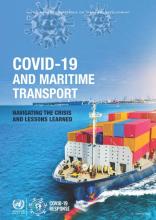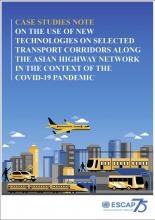
BUILDING CAPACITY TO MANAGE RISKS AND ENHANCE RESILIENCE A Guidebook for Ports
The guidebook presents a step-by-step approach to resilience building in the maritime supply chain. It sets out risk identification, assessment and management tools and techniques, and describes a resilience-building process for ports.
The guidebook emphasizes lessons learned and good practices and highlights relevant measures that can be implemented to prepare, respond and recover from disruptions.

Resilient Maritime Logistics Website
The Resilient Maritime Logistics website (https://resilientmaritimelogistics.unctad.org) hosts a guidebook for ports aiming at Building Capacity to Manage Risks and Enhance Resilience. It features risk identification, assessment, and management tools and approaches, case studies, good practices and a step-by-step resilience-building process for ports and other relevant maritime supply chain actors. The guidance focuses on three types of resilience-building actions and measures, namely:
- Before a disruption materializes.
- During a disruption.
- After a disruption.
A course structured around six modules and focusing on Port and Maritime Supply Chain Resilience accompanies the guidance on this website. The training will help to better understand the importance of well-functioning maritime supply chains and ports for highly interdependent world economies and the need to build their resilience in the face of heightened, uncertainty and disruptions.
The Resilient Maritime Logistics website and related content and material aim to help stakeholders across the maritime supply chain to better manage risks, prepare in the face of disruptions, ensure effective response measures and enable rapid recovery. Targeted stakeholders include (i) governmental planning and regulatory agencies; (ii) port authorities; (iii) port operators and port management companies; (iv) terminal operators; (v) infrastructure managers; (vi) freight forwarders; (vii) customs authorities; (viii) carriers and shipping companies; (ix) shippers and cargo owners; and (x) inland carriers and inland logistics operators (e.g. dry ports, inland container depots, warehouses, logistics and distribution centres). Collaboration between each of these stakeholders is critical for maritime supply chain agility and resilience-building.

COVID-19 and Maritime Trasport: Navigating the Crisis and Lessons Learned
UNCTAD's report "Covid-19 and maritime transport: Navigating the crisis and lessons learned" describes how the COVID-19 pandemic shocked the global maritime transport system and some of the key effects on the sector. It highlights challenges arising from the disruption across ports and hinterland connections and examines response and mitigation measures implemented by various stakeholders. It sets out the key lessons that can inform and guide preparedness and resilience-building efforts in transport and logistics.
The Model Subregional Agreement on Transport Facilitation
The Model Subregional Agreement on Transport Facilitation has been elaborated on the basis of findings of comparative studies between major subregional agreements on transport facilitation to which various ESCAP member States are parties, conducted in 2014-2015. It has been subsequently reviewed by two regional expert meetings held in 2015 and finalized with incorporation of ESCAP member States’ comments.
Training Manual on Operational Aspects of Multimodal Transport
Acknowledging the importance of multimodality in enhancing the seamlessness of supply chain and logistics network for ESCAP member countries, including landlocked developing countries (LLDCs), the “Training Manual on Operational Aspects of Multimodal Transport” was developed as part of ESCAP Transport Division initiatives to improve technical knowledge of the transport and logistics sector and to support human resource development and capacity-building of ESCAP member countries.

Seamless and smart connectivity along the Asian Highway network in the time of COVID-19
Freight transport operations poses the risks during the pandemics, especially if it is not fully computerized. As documents and goods continue to be subjected to physical checks for customs and other regulatory purposes, crew members and staff at border-crossing points and control terminals are exposed to the risk of contagion by the nature of their work. in this context, the use of information and communication technologies (ICT) and intelligent transport systems (ITS) is directly relevant to the pandemic response and recovery policies.Optimization of automation and digitalization can reduce the need for human interaction, making cross-borders transport safer and more resilient to disruptions. In this context, this technical note aims to offer policy recommendations for policy responses using new technologies and smart road solutions to preserve the regional transport connectivity in the time of the pandemics and other similar disruptions.
Training Manual on Logistics Information System
The “Training Manual on Logistics Information System” was developed as part of the activities of the UNDA project “Transport and trade connectivity in the age of pandemics: Contactless, seamless and collaborative UN solutions”.

Smart Railway Solutions for Trans-Asian Railway Network in the Times of COVID-19 Pandemic
To support trade and transport connectivity globally in times of pandemic the United Nation agencies have jointly launched a project titled- Trade and transport connectivity in times of pandemics: with overarching objective of developing contactless, seamless and collaborative solutions to preserve and further enhance the trade and transport connectivity. In Asia and the Pacific, ESCAP is leading the project and has initiated series of studies aimed at supporting countries in this direction.
The present study on smart railway solutions has been carried out under the project with aim to identify smart railway solutions that are proven to be successful elsewhere and are potentially replicable and scalable. Not all solutions would have equal importance or relevance for the railways of the region.

COVID-19 and maritime transport: Disruption and resilience in Africa
Impacts of the COVID-19 disruption on maritime trade flows, port calls, and liner shipping connectivity in Africa.
COVID-19 and maritime transport: Impacts and Responses
The report sets out the UNCTAD assessment of the COVID-19 impacts on the maritime supply chain and challenges faced. It also identifies response measures introduced by relevant stakeholders, and the lessons learned in terms of resilience-building and implications for the maritime supply chain of the future.